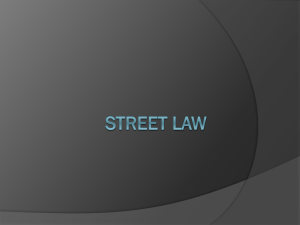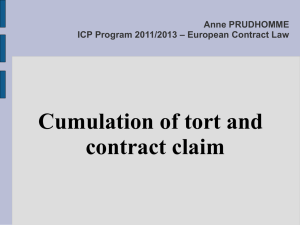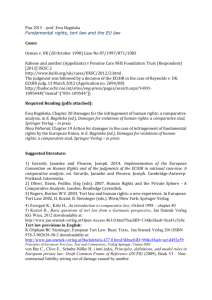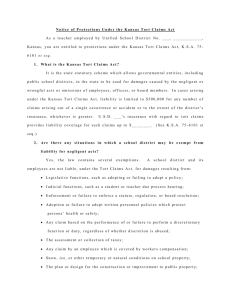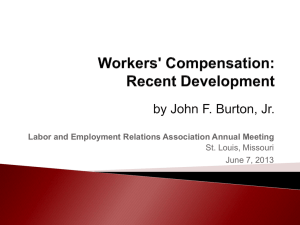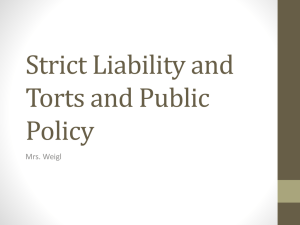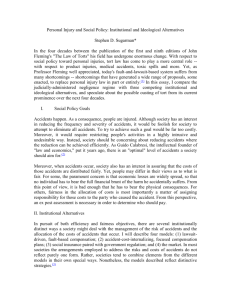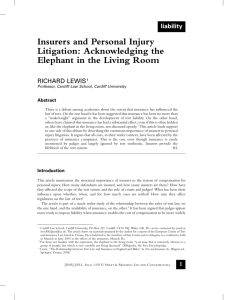Functions of Tort Law
advertisement
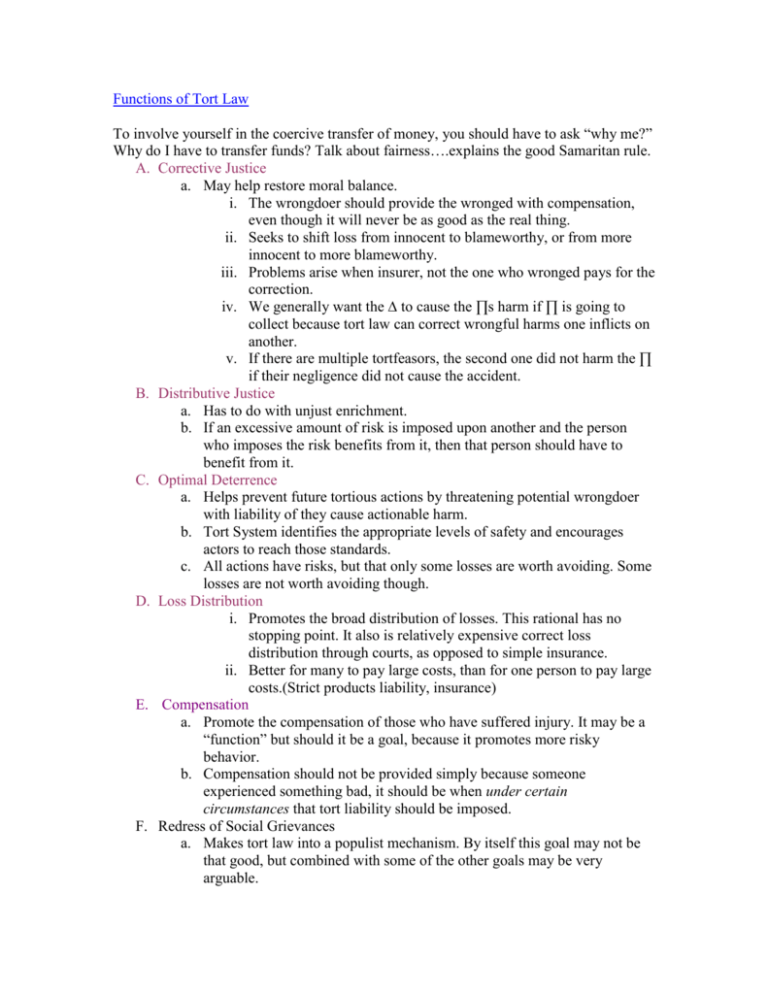
Functions of Tort Law To involve yourself in the coercive transfer of money, you should have to ask “why me?” Why do I have to transfer funds? Talk about fairness….explains the good Samaritan rule. A. Corrective Justice a. May help restore moral balance. i. The wrongdoer should provide the wronged with compensation, even though it will never be as good as the real thing. ii. Seeks to shift loss from innocent to blameworthy, or from more innocent to more blameworthy. iii. Problems arise when insurer, not the one who wronged pays for the correction. iv. We generally want the ∆ to cause the ∏s harm if ∏ is going to collect because tort law can correct wrongful harms one inflicts on another. v. If there are multiple tortfeasors, the second one did not harm the ∏ if their negligence did not cause the accident. B. Distributive Justice a. Has to do with unjust enrichment. b. If an excessive amount of risk is imposed upon another and the person who imposes the risk benefits from it, then that person should have to benefit from it. C. Optimal Deterrence a. Helps prevent future tortious actions by threatening potential wrongdoer with liability of they cause actionable harm. b. Tort System identifies the appropriate levels of safety and encourages actors to reach those standards. c. All actions have risks, but that only some losses are worth avoiding. Some losses are not worth avoiding though. D. Loss Distribution i. Promotes the broad distribution of losses. This rational has no stopping point. It also is relatively expensive correct loss distribution through courts, as opposed to simple insurance. ii. Better for many to pay large costs, than for one person to pay large costs.(Strict products liability, insurance) E. Compensation a. Promote the compensation of those who have suffered injury. It may be a “function” but should it be a goal, because it promotes more risky behavior. b. Compensation should not be provided simply because someone experienced something bad, it should be when under certain circumstances that tort liability should be imposed. F. Redress of Social Grievances a. Makes tort law into a populist mechanism. By itself this goal may not be that good, but combined with some of the other goals may be very arguable. G. Serve “Instrumental” Goals i. Identify Optimal Level Safety ii. Provide Financial Incentives to be at OLS in the future. (Deterrence Argument) iii. Provide Financial Incentives to be at Optimal Level of Activity iv. Spread Loss to Minimize Total Social Loss H. Deep Pocket Arguments a. Examination of traditional deep pocket arguments (products liability abnormally dangerous activity) make us think that they are really not about deep pockets, but about aimed at affecting activity levels by assigning costs to those who benefit from them b. When the tort law imposes liability in “no fault” injuries, it does so to serve instrumental goals relating to activity levels. Wealth not activity that should be addressed. c. Problems: There would be a sliding scale of wealth. Redistribution of wealth should be done in taxation, tort law to episodic of a system. Different Tensions: 1. Effective loss allocation (because of insurance or size of business vs. culpability 2. Corrective justice vs instrumental goals (medical malpractice and Good Samaritan Rule a. Good Samaritan Rule: You have to save or help someone (only by statute, Vermont) i. Positive 1. Ames: Should be accepted because it is morally unacceptable otherwise. 2. Bender: We are all connected and there is more at stake than liberty. 3. Posner: Consideration for G. Samaratin because of same situation in opposite circumstance. ii. Negative 1. Epstein: Threatens individual autonomy. Difficult to tell where liberty ends and obligation begins. In cases of multiple defendants where the Π chooses one person who could have rescued him, a “why me” problem exists. What about war victims? iii. Bice 1. law creates duty w/ $ (taxes go to starving children) & w/ forced service (draft includes soldiers, drs.). Difference = leg. v. tort (it’s legislature’s job to decide to impose a duty, not individual s). 2. Judge and Jury Homes wants to make a bright line test for unreasonableness. o Consistent with instrumental view of tort law. o Goes against CJ because there will be exceptions to the bright line view in extenuating circumstances. Ex-Post Biaso Courts fear the ex-post bias. Inferring negligence from the harm that occurred. o Juries sympathetic to hurt ∏, and infer negligence from the fact that harm was caused. (Pamela B Case) Stacking Problem o USC liable for 2 mill in damages when the criminal actually committed the crime. (Nola M) Specifics: Dram Shop Statutes: Statutes changed dram shop liability because courts got it wrong, Landlord Problems 1. Saelzler-Used causation as a method to prevent landlords from being liable, missed the legal theory that should have dealt with duty, and not causation. a. Ruled that as a matter of law landlord actions are not the cause of injury. Social Functions of Tort Law Revisited a. b. Recovery for injury i. Tort law: approximately 8% of injuries ii. Other mechanisms: 1. Social insurance 2. Workers’ compensation 3. Private insurance 4. Etc. Pierce i. Implications for goals of tort law: 1. Instrumental: financial incentives for parties act safely in the future a. Points out bias in how life is valued: value of income stream determines value of damages b. Damage rules don’t fully capture values that jury has in mind – tort law thus underperforms in its function to provide incentive to be at OLS going forward c. Jury is thinking about social wrongs, but damages don’t capture these (ex. child’s death) – D comes to do his C-B analysis based on the damages (which don’t fully capture) 2. Externalization: a. b. c. c. d. People don’t always file claims, and when they do, they often settle, for much less than the true value was Costs not put on the person who was making the decision Might even get into a situation where a D, going forward, feels that there is no risk at all Baker: “blood money” i. Litigation seems to be less concerned with deterrence – in ordinary course of litigation, insurance companies pay 1. People don’t go after individual Ds for anymore than their insurance will pay; don’t go after “blood money”, less incentive to be at OLS in the future, Structure of liability insurance ii. Effect on C/J: 1. D doesn’t feel effect 2. Especially undercut in situations where Ds insurance doesn’t cover P’s total loss iii. Argument that there might be some deterrence: 1. How much do insurance companies actually come back at people who have been found liable and jack up their premiums to provide incentive to be at OLS in the future? *Loss spreading is being served under this analysis Abel: functions of tort law i. Moral judgment: 1. If someone drives quite negligently and causes only a little harm and another drives slightly negligently and causes a lot of harm, tort law won’t judge them based on relative wrongfulness of their conduct – skewed 2. Rebuttal (Bice): but, it’s about shifting losses, not making moral judgments per se – this isn’t as a great a concern when it is only confined to tort law as opposed to whole legal system ii. Respond to victim’s need for compensation 1. If a D causes harm but it not at fault, tort law doesn’t provide compensation, and yet the need for it is there 2. Rebuttal (Bice): who ever though that the tort system was going to provide full compensation? It’s shifting for particular reasons – fact that P was injured and needs money is not sufficient reason for shifting loss onto a particular D; it would be an arbitrary shift if you don’t have a reason



